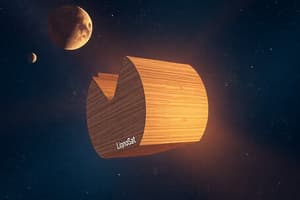Podcast
Questions and Answers
What is the primary objective of the LignoSat mission?
What is the primary objective of the LignoSat mission?
- To establish a permanent human settlement on the Moon.
- To test the durability of wood in the harsh conditions of space. (correct)
- To measure the amount of aluminum oxide in the upper atmosphere.
- To develop new methods for extracting resources from asteroids.
Why is aluminum, the material primarily used in current satellites, considered an environmental concern?
Why is aluminum, the material primarily used in current satellites, considered an environmental concern?
- Aluminum is too heavy, making launches more expensive.
- Aluminum corrodes rapidly in space, creating debris.
- Burning aluminum creates water and carbon dioxide, contributing to global warming.
- Burning aluminum releases aluminum oxide particles that could damage the ozone layer. (correct)
Which university is leading the LignoSat Space Wood Project?
Which university is leading the LignoSat Space Wood Project?
- Kyoto University (correct)
- Stanford University
- University of Oxford
- Massachusetts Institute of Technology
For how long was the initial wood sample panel exposed to space before being analyzed by researchers?
For how long was the initial wood sample panel exposed to space before being analyzed by researchers?
What potential long-term vision do the researchers have regarding the use of wood in space, beyond satellite construction?
What potential long-term vision do the researchers have regarding the use of wood in space, beyond satellite construction?
LignoSat is primarily constructed from wood sourced from which type of tree?
LignoSat is primarily constructed from wood sourced from which type of tree?
If LignoSat's mission goals are realized, how might this advancement influence the lifecycle of future satellites at their end-of-life stage?
If LignoSat's mission goals are realized, how might this advancement influence the lifecycle of future satellites at their end-of-life stage?
Assume that LignoSat's wooden structure exhibits unforeseen degradation in orbit due to radiation exposure, releasing organic compounds. Which of the following effects, while not explicitly mentioned, is the MOST plausible unintended consequence of this degradation, considering known space environment interactions?
Assume that LignoSat's wooden structure exhibits unforeseen degradation in orbit due to radiation exposure, releasing organic compounds. Which of the following effects, while not explicitly mentioned, is the MOST plausible unintended consequence of this degradation, considering known space environment interactions?
Flashcards
LignoSat
LignoSat
World's first satellite made mostly of wood.
LignoSat Space Wood Project
LignoSat Space Wood Project
Kyoto University and Sumitomo Forestry
LignoSat Mission
LignoSat Mission
To determine if wood can withstand space conditions and explore environmentally friendly spacecraft designs.
Satellite Burning Byproduct
Satellite Burning Byproduct
Signup and view all the flashcards
Wooden Satellites Environmental Advantage
Wooden Satellites Environmental Advantage
Signup and view all the flashcards
Wooden Satellites Goal
Wooden Satellites Goal
Signup and view all the flashcards
Wooden Satellite Testing Advantage
Wooden Satellite Testing Advantage
Signup and view all the flashcards
Future Space Construction
Future Space Construction
Signup and view all the flashcards
Study Notes
- LignoSat, the world's first satellite made mostly of wood, arrived at the International Space Station (ISS) aboard a SpaceX cargo capsule on November 5, 2024.
- LignoSat is named after the Latin word for "wood."
- The palm-sized satellite will be launched from the ISS into Earth’s orbit later this month.
- LignoSat's mission is to test wood's ability to withstand the harsh conditions of space.
- A successful mission could lead to more environmentally friendly spacecraft designs.
- The LignoSat Space Wood Project is a collaboration between Japan's Kyoto University and Sumitomo Forestry.
- Researchers sent a small panel with three different wood samples to the ISS in 2022.
- The panel was exposed to space for ten months and returned to Earth in early 2023.
- Magnolia wood was chosen for the satellite after analyzing the results of the panel test.
- Professor Koji Murata of Kyoto University noted that wood was once considered an outdated technology, not applicable to cutting-edge science.
- The primary reason for testing a wooden satellite is to reduce space junk.
- Current satellites are mainly made of aluminum, which reacts with oxygen and releases aluminum oxide particles when burning up in Earth's atmosphere.
- Aluminum oxide particles released by satellites can potentially damage the ozone layer.
- Wooden satellites would only leave behind water and carbon dioxide, alleviating the issue of aluminum oxide particles.
- Takao Doi, an aerospace engineer with Kyoto University, stated the alumina particles from burning satellites can float in the upper atmosphere for years and eventually harm the environment.
- Researchers envision a future where trees could be grown on the Moon and Mars.
- Successfully testing a wooden satellite would prove that wood can withstand harsh space conditions.
- Takao Doi believes timber, a self-producible material, could enable humans to build houses and live/work in space permanently.
- LignoSat will orbit Earth for six months to gather data before burning up in the atmosphere.
- Professor Murata and his team plan to use the data to design larger and more advanced wooden satellites and devices.
Studying That Suits You
Use AI to generate personalized quizzes and flashcards to suit your learning preferences.





